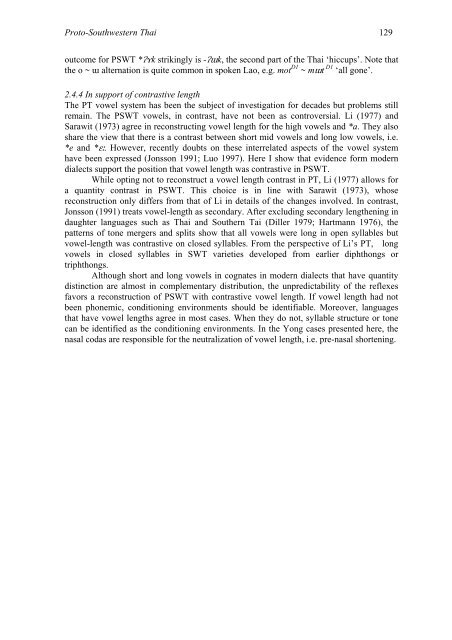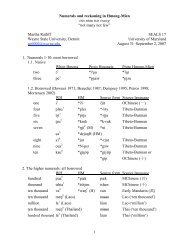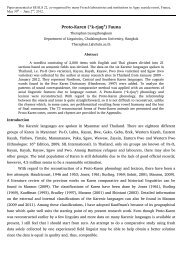proto-southwestern-tai revised: a new reconstruction - seals 22
proto-southwestern-tai revised: a new reconstruction - seals 22
proto-southwestern-tai revised: a new reconstruction - seals 22
Create successful ePaper yourself
Turn your PDF publications into a flip-book with our unique Google optimized e-Paper software.
Proto-Southwestern Thai 129<br />
outcome for PSWT *ʔɤk strikingly is -ʔɯk, the second part of the Thai ‘hiccups’. Note that<br />
the o ~ ɯ alternation is quite common in spoken Lao, e.g. mot D1 ~ mɯt D1 ‘all gone’.<br />
2.4.4 In support of contrastive length<br />
The PT vowel system has been the subject of investigation for decades but problems still<br />
remain. The PSWT vowels, in contrast, have not been as controversial. Li (1977) and<br />
Sarawit (1973) agree in reconstructing vowel length for the high vowels and *a. They also<br />
share the view that there is a contrast between short mid vowels and long low vowels, i.e.<br />
*e and *ɛː. However, recently doubts on these interrelated aspects of the vowel system<br />
have been expressed (Jonsson 1991; Luo 1997). Here I show that evidence form modern<br />
dialects support the position that vowel length was contrastive in PSWT.<br />
While opting not to reconstruct a vowel length contrast in PT, Li (1977) allows for<br />
a quantity contrast in PSWT. This choice is in line with Sarawit (1973), whose<br />
<strong>reconstruction</strong> only differs from that of Li in de<strong>tai</strong>ls of the changes involved. In contrast,<br />
Jonsson (1991) treats vowel-length as secondary. After excluding secondary lengthening in<br />
daughter languages such as Thai and Southern Tai (Diller 1979; Hartmann 1976), the<br />
patterns of tone mergers and splits show that all vowels were long in open syllables but<br />
vowel-length was contrastive on closed syllables. From the perspective of Li’s PT, long<br />
vowels in closed syllables in SWT varieties developed from earlier diphthongs or<br />
triphthongs.<br />
Although short and long vowels in cognates in modern dialects that have quantity<br />
distinction are almost in complementary distribution, the unpredictability of the reflexes<br />
favors a <strong>reconstruction</strong> of PSWT with contrastive vowel length. If vowel length had not<br />
been phonemic, conditioning environments should be identifiable. Moreover, languages<br />
that have vowel lengths agree in most cases. When they do not, syllable structure or tone<br />
can be identified as the conditioning environments. In the Yong cases presented here, the<br />
nasal codas are responsible for the neutralization of vowel length, i.e. pre-nasal shortening.





